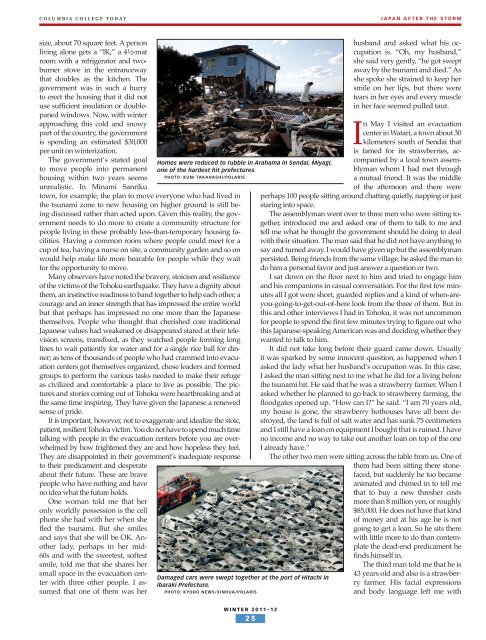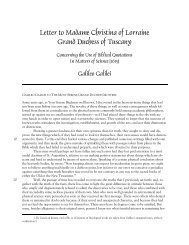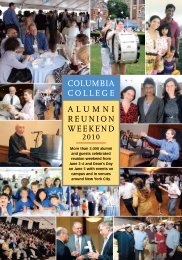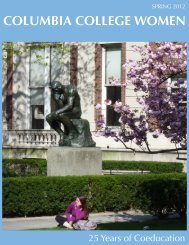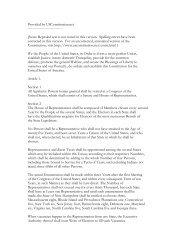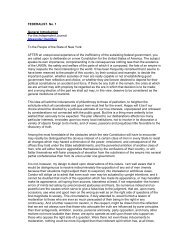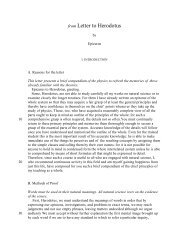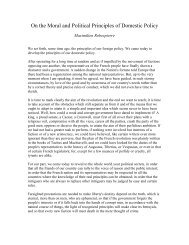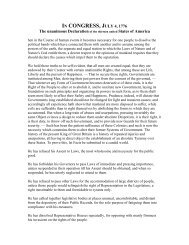Japan Storm - Columbia College - Columbia University
Japan Storm - Columbia College - Columbia University
Japan Storm - Columbia College - Columbia University
You also want an ePaper? Increase the reach of your titles
YUMPU automatically turns print PDFs into web optimized ePapers that Google loves.
COLUMBIA COLLEGE TODAY JAPAN AFTER THE STORM<br />
size, about 70 square feet. A person<br />
living alone gets a “lK,” a 4½-mat<br />
room with a refrigerator and twoburner<br />
stove in the entranceway<br />
that doubles as the kitchen. The<br />
government was in such a hurry<br />
to erect the housing that it did not<br />
use sufficient insulation or doublepaned<br />
windows. Now, with winter<br />
approaching this cold and snowy<br />
part of the country, the government<br />
is spending an estimated $30,000<br />
per unit on winterization.<br />
The government’s stated goal<br />
to move people into permanent<br />
housing within two years seems<br />
unrealistic. In Minami Sanriku<br />
town, for example, the plan to move everyone who had lived in<br />
the tsunami zone to new housing on higher ground is still being<br />
discussed rather than acted upon. Given this reality, the government<br />
needs to do more to create a community structure for<br />
people living in these probably less-than-temporary housing facilities.<br />
Having a common room where people could meet for a<br />
cup of tea, having a nurse on site, a community garden and so on<br />
would help make life more bearable for people while they wait<br />
for the opportunity to move.<br />
Many observers have noted the bravery, stoicism and resilience<br />
of the victims of the Tohoku earthquake. They have a dignity about<br />
them, an instinctive readiness to band together to help each other, a<br />
courage and an inner strength that has impressed the entire world<br />
but that perhaps has impressed no one more than the <strong>Japan</strong>ese<br />
themselves. People who thought that cherished core traditional<br />
<strong>Japan</strong>ese values had weakened or disappeared stared at their television<br />
screens, transfixed, as they watched people forming long<br />
lines to wait patiently for water and for a single rice ball for dinner;<br />
as tens of thousands of people who had crammed into evacuation<br />
centers got themselves organized, chose leaders and formed<br />
groups to perform the various tasks needed to make their refuge<br />
as civilized and comfortable a place to live as possible. The pictures<br />
and stories coming out of Tohoku were heartbreaking and at<br />
the same time inspiring. They have given the <strong>Japan</strong>ese a renewed<br />
sense of pride.<br />
It is important, however, not to exaggerate and idealize the stoic,<br />
patient, resilient Tohoku victim. You do not have to spend much time<br />
talking with people in the evacuation centers before you are overwhelmed<br />
by how frightened they are and how hopeless they feel.<br />
They are disappointed in their government’s inadequate response<br />
to their predicament and desperate<br />
about their future. These are brave<br />
people who have nothing and have<br />
no idea what the future holds.<br />
One woman told me that her<br />
only worldly possession is the cell<br />
phone she had with her when she<br />
fled the tsunami. But she smiles<br />
and says that she will be OK. Another<br />
lady, perhaps in her mid-<br />
60s and with the sweetest, softest<br />
smile, told me that she shares her<br />
small space in the evacuation center<br />
with three other people. I assumed<br />
that one of them was her<br />
Homes were reduced to rubble in Arahama in Sendai, Miyagi,<br />
one of the hardest hit prefectures.<br />
PHOTO: KUNI TAKAHASHI/POLARIS<br />
Damaged cars were swept together at the port of Hitachi in<br />
Ibaraki Prefecture.<br />
PHOTO: KYODO NEWS/XINHUA/POLARIS<br />
WINTER 2011–12<br />
25<br />
husband and asked what his occupation<br />
is. “Oh, my husband,”<br />
she said very gently, “he got swept<br />
away by the tsunami and died.” As<br />
she spoke she strained to keep her<br />
smile on her lips, but there were<br />
tears in her eyes and every muscle<br />
in her face seemed pulled taut.<br />
In May I visited an evacuation<br />
center in Watari, a town about 30<br />
kilometers south of Sendai that<br />
is famed for its strawberries, accompanied<br />
by a local town assemblyman<br />
whom I had met through<br />
a mutual friend. It was the middle<br />
of the afternoon and there were<br />
perhaps 100 people sitting around chatting quietly, napping or just<br />
staring into space.<br />
The assemblyman went over to three men who were sitting together,<br />
introduced me and asked one of them to talk to me and<br />
tell me what he thought the government should be doing to deal<br />
with their situation. The man said that he did not have anything to<br />
say and turned away. I would have given up but the assemblyman<br />
persisted. Being friends from the same village, he asked the man to<br />
do him a personal favor and just answer a question or two.<br />
I sat down on the floor next to him and tried to engage him<br />
and his companions in casual conversation. For the first few minutes<br />
all I got were short, guarded replies and a kind of when-areyou-going-to-get-out-of-here<br />
look from the three of them. But in<br />
this and other interviews I had in Tohoku, it was not uncommon<br />
for people to spend the first few minutes trying to figure out who<br />
this <strong>Japan</strong>ese-speaking American was and deciding whether they<br />
wanted to talk to him.<br />
It did not take long before their guard came down. Usually<br />
it was sparked by some innocent question, as happened when I<br />
asked the lady what her husband’s occupation was. In this case,<br />
I asked the man sitting next to me what he did for a living before<br />
the tsunami hit. He said that he was a strawberry farmer. When I<br />
asked whether he planned to go back to strawberry farming, the<br />
floodgates opened up. “How can I?” he said. “I am 70 years old,<br />
my house is gone, the strawberry hothouses have all been destroyed,<br />
the land is full of salt water and has sunk 75 centimeters<br />
and I still have a loan on equipment I bought that is ruined. I have<br />
no income and no way to take out another loan on top of the one<br />
I already have.”<br />
The other two men were sitting across the table from us. One of<br />
them had been sitting there stonefaced,<br />
but suddenly he too became<br />
animated and chimed in to tell me<br />
that to buy a new thresher costs<br />
more than 8 million yen, or roughly<br />
$85,000. He does not have that kind<br />
of money and at his age he is not<br />
going to get a loan. So he sits there<br />
with little more to do than contemplate<br />
the dead-end predicament he<br />
finds himself in.<br />
The third man told me that he is<br />
43 years old and also is a strawberry<br />
farmer. His facial expressions<br />
and body language left me with


